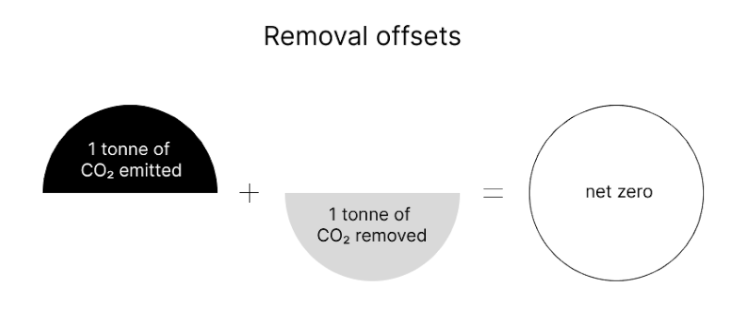· 4 min read
This article is part of Carbon Academy, the ultimate free and comprehensive guide on key carbon concepts
Introduction
Carbon Offsets provide various options for compensating for emissions. These options can largely be categorized into two main groups: those centered on carbon avoidance and reductions, and those focused on carbon removal.
While both carbon removal projects and carbon reduction projects are both strategies aimed at mitigating climate change, they operate in different ways.
Let us illustrate the main differences between the two.
1. Definition
a. Carbon avoidance/reduction
Carbon reduction offsets typically involve projects or activities that aim to prevent or reduce the emission of greenhouse gasses. Carbon avoidance/reduction initiatives offset emissions by preventing the release of CO2 in alternative locations.
Projects of this type include: Forest conservation projects, Clean Cooking Stove Programs, and Energy Efficiency Initiatives:
- Forest conservation projects: activities which avoid the release of emissions from the conversion of forests into severely forested or degraded land. One of these is REDD+, which involves paying a land owner not to tear it down or convert it to other land uses like agriculture or development. REDD+ projects often combine multiple activities, like improved forest management, afforestation/reforestation endeavors, re-vegetation schemes, and alternative livelihood programs
- Clean cooking stove programs: reducing emissions by providing developing nations with fuel-efficient cookstoves, so that they no longer have to utilize solid fuels like wood, coal, or agricultural residues, resulting in significant smoke emissions and other detrimental pollutants
- Energy efficiency initiatives: involving changes in industrial processes to lower emissions and implementation of renewable energy sources
b. Carbon removal
Carbon removal projects involve removing carbon dioxide from the atmosphere and, in some cases, securely storing them in carbon sinks, often in the ground.
Carbon removal projects include activities like:
- Afforestation (planting trees) and Reforestation
- DACCS (Direct Air Carbon Capture & Storage)
- BECCS (Bioenergy with Carbon Capture & Storage)
- Ocean-based methods like algae cultivation, and soil carbon sequestration
- Enhanced weathering
2. Comparing carbon reduction vs. removal offsets
Let us now offer a brief comparison of these two offsets, focusing on 4 critical aspects: Net Zero Potential, Time & Impact, Costs, Measurement.
a. Net zero potential
-
Carbon Avoidance/Reduction
The focus is on minimizing the carbon footprint of a particular activity or process and preventing additional greenhouse gasses from being emitted. While they help reduce emissions, they represent a conservative measure, in that they may not fully offset the total amount, and there might still be some residual emissions associated with the activity.

-
Carbon Removal
These projects result in a net reduction of atmospheric carbon. The amount of carbon removed equals or exceeds the amount emitted, leading to a net-zero or even a net-negative impact on the overall carbon balance. These projects thus go beyond merely preventing new emissions, actively working to draw down and store existing atmospheric carbon.

b. Time & impact
-
Carbon Avoidance/Reduction
The impact of carbon avoidance projects is immediate. For example, switching to renewable energy sources or implementing energy-efficient technologies can result in an immediate reduction in emissions. -
Carbon Removal
The impact of carbon removal projects is typically realized over a more extended period. Trees, for instance, need time to grow and sequester carbon, and direct air capture technologies require ongoing operation to be effective.
c. Costs
-
Carbon Avoidance/Reduction
Implementing cleaner technologies or adopting sustainable practices may involve upfront costs, but they can often lead to long-term savings through reduced energy consumption and operating costs. -
Carbon Removal
Carbon removal technologies are far more expensive to implement than carbon reduction methodologies, and costs can vary based on the scale and technology used.
d. Measurement
- While scaling carbon removal proves to be much more challenging given its costs, measuring and verifying its efficacy, particularly with carbon removal technologies, tends to be more feasible.
3. Conclusion
The distinction between carbon removal offsets and carbon reduction offsets lies in the nature of the emissions they address and the impact they have on the overall carbon balance.
While carbon reduction offsets focus on minimizing emissions from specific activities, carbon removal offsets actively aim to draw down and store carbon from the atmosphere, potentially achieving a net-zero or net-negative impact.
Both types of offsets play important roles in the broader context of climate change mitigation, and organizations often use a combination of both to address their carbon footprints and contribute to global efforts to combat climate change.
While carbon reduction offsets offer a viable solution for the present due to their lower costs, removals are the path to take for the future to generate a positive impact in our fight against climate change.
Are you a sustainability professional? Please subscribe to our weekly CSO Newsletter and Carbon Newsletter






